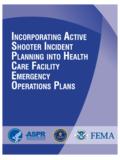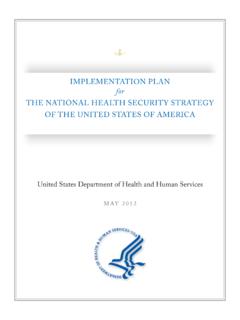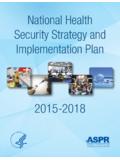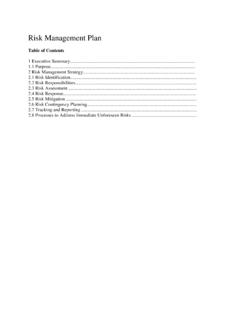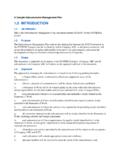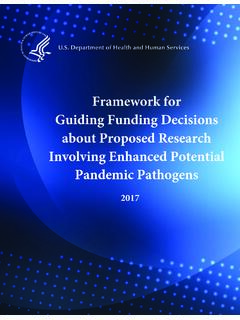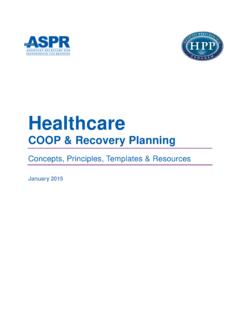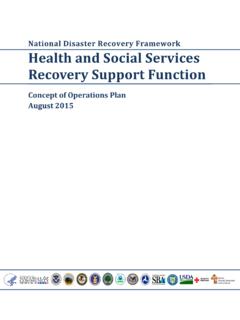Transcription of Health Industry Cybersecurity Practices
1 Health Industry Cybersecurity Practices : Managing Threats and Protecting PatientsThis page intentionally left blank1 Table of ContentsDisclaimer ..2 Letter from the HHS Deputy Secretary ..3 Foreword ..4 Executive Summary ..5 Call to Action: Cybersecurity a Priority for Patient Safety ..5 Cybersecurity Act of 2015: Task Group Undertakes a Legislative ..5 The Publication: Health Industry Cybersecurity Practices ..6 Audience and Publication Components ..6 Cybersecurity Threats and Mitigation Practices ..6 Cybersecurity Attacks Continue to Affect the Health Care Industry ..7 Why Should You Worry About Cybersecurity and Take Action Now? ..9 How Does This Publication Help Me? ..10 Can It Happen To Me? ..10 Where Do I Fit? ..11Be Proactive: Hand Hygiene for Cybersecurity .
2 12 Current Threat Scenarios Facing the Health Care Industry ..13 Explaining Threats and Vulnerabilities ..13A Translation: Threats, Vulnerabilities, Impact, and Practices ..14 Introducing Current Threats to the Health Care Industry ..14 Threat: E-mail Phishing Attack ..16 Threat: Ransomware Attack ..18 Threat: Loss or Theft of Equipment or Data ..20 Threat: Insider, Accidental or Intentional Data Loss ..22 Threat: Attacks Against Connected Medical Devices That May Affect Patient Safety ..24 Cybersecurity Practices ..26 Looking Ahead ..27 Overview of Technical Volumes ..28 Acknowledgements ..31 Appendix A: Acronyms and Abbreviations ..32 Appendix B: References ..33 TablesTable 1: Selecting the Best Fit For Your Organization ..11 Table 2: Suggested Practices to Combat E-mail Phishing Attacks.
3 17 Table 3: Suggested Practices to Combat Ransomware 19 Table 4: Suggested Practices to Combat Loss or Theft of Equipment or Data ..21 Table 5: Suggested Practices to Combat Insider, Accidental or Intentional Data Loss ..23 Table 6: Suggested Practices to Combat Attacks Against Medical Devices That May Affect Patient Safety ..25 Table 7: Cybersecurity Practices and Sub- Practices for Small Organizations ..28 Table 8: Cybersecurity Practices and Sub- Practices for Medium Organizations ..29 Table 9: Cybersecurity Practices and Sub- Practices for Large Organizations ..302 DisclaimerThis document is provided for informational purposes only. Use of this document is neither required by nor guarantees compliance with federal, state, or local laws.
4 Please note that the information presented may not be applicable or appropriate for all Health care providers and organizations. This document is not intended to be an exhaustive or definitive source on safeguarding Health information from privacy and security risks. 3 Letter from the HHS Deputy SecretaryCyberattacks are an increasing threat across all critical infrastructure sectors. For the Health sector, cyberattacks are especially concerning because these attacks can directly threaten not just the security of our systems and information but also the Health and safety of American patients. We are under constant cyberattack in the Health sector, and no organization can escape that reality. While innovation in Health information technology is a cause for optimism and increasing sophistication in Health IT holds the promise to help address some our most intractable problems, whether in clinical care, fundamental research, population Health or Health system design, our technology will work for us only if it is secure.
5 Information systems are crucial to today and tomorrow s healthcare system, so we must take every step possible to protect has a holistic view of the intersection between Cybersecurity and healthcare, including data protection and response to cyber threats. Cybersecurity remains a top priority at HHS and is reflected in recent Cybersecurity initiatives, including the development of this publication, titled Health Industry Cybersecurity Practices : Managing Threats and Protecting Patients. This publication is the result of the collaborative work HHS and its Industry partners embarked on more than a year ago namely, the development of practical, understandable, implementable, Industry -led, and consensus-based voluntary Cybersecurity guidelines to cost-effectively reduce Cybersecurity risks for Health care organizations of varying sizes, ranging from local clinics, regional hospital systems, to large Health care systems.
6 Many of the most influential Industry organizations in healthcare came together as the 405(d)i i Cybersecurity Act of 2015, Public Law 114-113, Section 405(d) Aligning Health Care Industry Security Approaches codified at 6 1533 (d) Task Group in May 2017, to plan, develop and draft this publication. HHS engaged a diverse group of more than 150 healthcare and Cybersecurity experts through the Health Sector Coordinating Council as well as our government partners. The Task Group focused on building a set of voluntary, consensus-based principles and Practices to improve Cybersecurity in the Health sector. The group determined that it was not feasible to address every Cybersecurity challenge across the large and complex healthcare Industry .
7 Therefore, it focused on the five most prevalent Cybersecurity threats and the ten Cybersecurity Practices to significantly move the needle for a broad range of organizations within our outcomes have come from a shared commitment to addressing this challenge. With each step, we will provide a safer and more secure environment for providers to deliver services, for manufacturers to develop products, and for patients to receive high-quality, uninterrupted care. Cybersecurity is a shared responsibility. HHS will continue to build partnerships with stakeholders to become a better, more coordinated team. Together, we can take on the Cybersecurity challenges that lie have achieved great progress already but, as we know, in Cybersecurity our work is never finished.
8 I encourage anyone interested in Cybersecurity and patient safety to get involved. If you are interested in joining the 405(d) Task Group, reach out to the Task Group directly at /s/ Eric Hargan Deputy Secretary of Health and Human Services 4 Foreword from Co-LeadsOver the past decade, the threat to the Health care Industry has increased dramatically along with the sophistication of cyber -attacks. Industry and government alike have recognized the dawning of this new era. For each gain delivered by automation, interoperability, and data analytics, the vulnerability to malicious cyber -attacks increases as well. To thwart these attacks before they occur, it is essential for Health care organizations to establish, implement, and maintain current and effective Cybersecurity Cybersecurity Act of 2015 (CSA) (Public Law 114-113)1 establishes a trusted platform and a tighter partnership between the United States ( ) government and the private sector, recognizing that our critical infrastructure, economic solvency, and personal safety have become intertwined with our digital 405(d) of CSA calls for Aligning Health Care Industry Security Approaches.
9 It is with this imperative that Industry and government came together under the auspices of the 405(d) Task Group, starting in May 2017. The Task Group focused on building a set of voluntary, consensus-based principles and Practices to ensure Cybersecurity in the Health Care and Public Health (HPH) sector. This document reflects the Task Group s current Task Group determined that it was not feasible to address every Cybersecurity challenge across the large and complex Health care Industry in a single document. The Task Group therefore made the decision to focus on the most impactful threats, with the goal of significantly moving the Cybersecurity needle for a broad range of organizations within the HPH sector comprises many different types of organizations, widely varying in size, complexity, capabilities, and available resources.
10 The 405(d) Task Group determined that it is critical to tailor Cybersecurity Practices to a Health care organization s size, namely, small, medium-sized, or large. Each organization has specific Cybersecurity -related attributes, strengths, and vulnerabilities, and, for the recommended Cybersecurity Practices to be optimally effective, organizations must tailor them to their unique , the Task Group recognized the complexity of Cybersecurity threats. There is no simple method to combat them all. As a result, the Task Group provided a model, aligned with National Institute of Standards and Technology (NIST), and a method for assessment, which is discussed in Appendix E of this publication. This assessment will help organizations determine the implementation priority of the Practices set forth by the Task Group based upon the threats with which they are most do not expect the Practices provided in this publication to become a de facto set of requirements that all organizations must implement.
